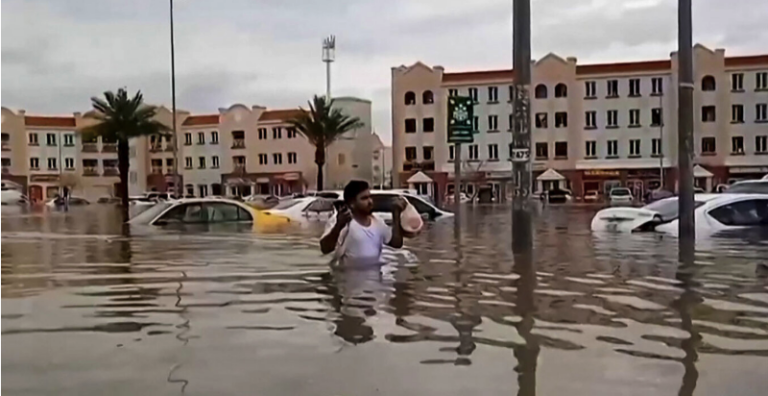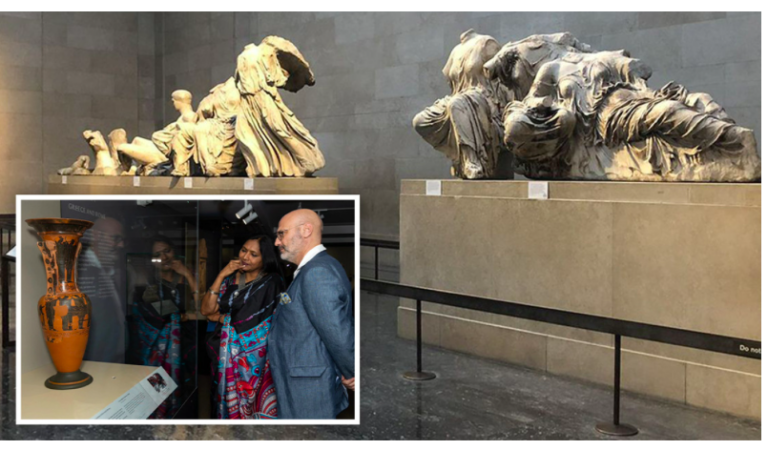Last June, the Crown Prince of Dubai, Sheikh Hamdan bin Mohammed bin Rashid Al Maktoum, approved a $21.8 billion fund to expand and redesign the sewerage system.
In January, a new flood management agency was established in the city. The rain, the heaviest in 75 years, which turned the city of Dubai into a vast lagoon, anticipated the plans.
Dubai’s streets turned into rivers after heavy rains and flash floods. pic.twitter.com/Isktb7JXia
— DW News (@dwnews) April 16, 2024
Now, as the waters retreat, they reveal the extent of the devastation from the historic weather that caused 19 deaths in neighbouring Oman and at least one in Dubai.
It’s not just images of chaos at Dubai airport – which is also the busiest on the planet – with travellers crowding the floors to sleep. Nor the ultra-luxury supercars buried under tons of water.
It’s roads whose pavement gave way under the water (even the famous 12-lane Sheikh Zayed Avenue was flooded, causing an hour-long traffic jam in its ‘dry’ parts), houses flooded and no longer habitable. Even in the skyscrapers, residents had to climb stairs up dozens of floors – as the elevators in the basements were flooded – only to find that their apartment had no water supply, no electricity, no telephone, no Internet connection. And while in some neighbourhoods they moved around in inflatables or even surfboards, part of the city’s Metro was also damaged.
Local authorities do not yet have figures available on the total amount of damage caused. Besides, tankers are still pumping water and mud from the most affected areas.
More so, moreover, in Dubai, there is a debate whether the “bombardment” of clouds with salt, a technique called “cloud seeding”, is responsible for the historic storm.
In the United Arab Emirates, this technique has been used since the 90s to deal with drought as in many cases it can cause rainfall.
In this particular case, however, in response to rumours that a Dubai National Meteorological Centre aircraft that flew over on Sunday caused the disaster, meteorologists at the centre denied there was any connection.
And they say it would have been impossible to cause such a deluge.
What the scientists do say is that the increasingly warm temperatures of Dubai and, of course, the wider region, contributed to the historic bad weather and will do so more often in the future.
As they explain, warmer air can hold more moisture (about 7% for every extra degree Celsius) which can increase the intensity of rainfall.
In Dubai’s case, the problem is not only the poor drainage system – as many streets don’t even have drains and rainwater ends up in houses, or pools in them.
PM Mitsotakis: “We must protect our borders” – Joint statements with Tusk in Warsaw
It is also the fact that the city of Dubai has few green spaces to absorb some of the moisture.
Experts say the city needs to adapt to the new conditions and adjust its infrastructure to protect it from the new reality that climate change is bringing it with: In addition to long periods of drought and heat – something normal for the desert in which it is built – be prepared for heavy rainfall, capable of causing flooding.
For this, it was the “bad weather of the century”, the worst Dubai has seen since 1949, when weather records were kept, but probably not the last of this intensity that it will experience in the coming years…
Ask me anything
Explore related questions





